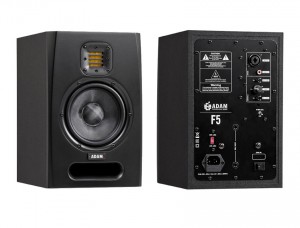Review: ADAM F5 Studio Monitors
I mix quite a bit for film and TV where dialogue is king. For those projects, I like monitors that put the human speaking voice front and center. Many consumer TV’s, flat screens, laptops, tablets, and the rest favor the voice at the expense of other things to support dialogue to picture in a frugal manner. I’ve got to be sure my work sounds good on those components, while still making the best use of high-end systems.
Towards that objective I gravitate to monitors that are unforgiving. I like to hear all the warts: little crackles, clicks, bad edits, the opening theme song that started out as an MP3 – it’s rough out there. If the monitors flatter everything they play, I could get into trouble.
As a result, I live in a world of my own little personal speakers that I trust and have given me great results over a number of years. I know that when I mix on them, I will get a reliable translation out in the world, no matter the consumer listening system.
An Affordable ADAM
Having recently made the move to mixing out of my apartment where the commute and the take-out are superior, I have had to make some adjustments to my listening routine.
My existing system: well-known small stereo near-fields with a sub. While I’ve done decent soundproofing to my studio (not only do I mix in it, my wife – a classically trained soprano – rehearses arias there) I don’t like to assume that the neighbors won’t notice. So I tend to work at moderate levels, cranking it a bit once I think it’s close enough to check and make final adjustments.
In a fully soundproofed studio I mix at level (79db for broadcast) then check it quietly to be sure the balances hold up, so here it’s the other way around. I like this practice because it reveals the problems that show up on a variety of systems: unevenness of dialogue, troublesome production sound and rogue low-end stuff that makes it into the subwoofer of the untamed home entertainment center.
As I adjust to the new smaller room I find myself checking my mixes on a greater variety of systems and spaces than I once did just to be safe. So it seemed a good time to revisit my monitor setup, just as I was given the opportunity to test-drive the new ADAM F5s. Perfect timing.
ADAM Audio introduced the A series of speakers a number of years ago and they immediately found homes in many of the world’s best studios. Succeeded by the AX series, they are well-established favorites and priced competitively with other eagerly sought-after high-end monitors.
But the AX’s may be out of reach for smaller studios or facilities that run multiple rooms.
At a street price of $249.95 per monitor, the newer F5’s constitute an entry-level monitor for those with more modest setups or those who may desire a second set of speakers to stay honest. Could the folks at ADAM Audio have figured out how to make a comparable product to their venerable AX series for a significantly lower price? That was the big question.
Mixing Post with the F5
The F5 is a two-way powered, bi-amplified speaker with 5” woofer below the distinctive Advanced Ribbon Technology (ART) tweeters, which have been updated for the new models. A bass port is featured on the bottom front of the unit. On the back are controls for overall level, a hi shelf EQ fixed at > 5kHz and low shelf fixed at < 300 Hz are provided. An 80 Hz high-pass filter switch is included in the event that one wishes to connect an ADAM SubF subwoofer. Inputs are a +4 balanced combo connector that sits above an RCA jack for those with -10 interfacing. A power switch, IEC cable & socket and mounting points for speaker brackets round out the package.
I unpacked the ADAM’s. Good heft, and the fit and finish are solid. I set them up at ear height and connected them to the Amek BC2 mixing board that I use to control my monitors. The combo jack is nice to match the cables I happened to have on hand.
The speakers sit on an overbridge, their backs within a few inches of the wall, so I adjusted the < 300hz low shelf down by 3 DB to compensate (the knee is at 300hz but it’s 3db down at 100hz). I pinked the room, set the playback to 79db and I was ready to go.
First, I began with some comparison listening, Loading up some of my existing mixes. I was initially thrown by the much rounder bass response of the F5’s. I listened to some trailers, a documentary, and a sound effects build-out that I was doing for an animated feature. I liked the sound but it wasn’t what I was accustomed to – I would say that the ADAM’s flattered my mixes. As I am suspicious of flattery, I moved on to some actual audio creation.
Into the sound effects build I plunged. This animated feature will be mixed in 5.1 for theatrical release. I like to be sure I’m providing the re-recording mixer with all of the elements they will need to make the sound do all of the things a movie might want. One element of this film is robots. Lots of robots. They eat things and punch through walls, tear stuff apart, and one of them has feet that are big like buildings.
I have to design tracks that convey all of the movements of the robots in a cinematic way. To be punchy and huge at the same time, I need low frequencies that don’t step on one another, and I also need mids plus highs to fill it out. It’s an awful lot of detail and I have to move pretty quickly.
The ADAM’s let me hear everything that was going on and made progress pretty straightforward. I checked my work back on my old stereo plus sub setup and the balances held up well. The ADAM’s have a more integrated balance across all frequencies than I’m used to, which makes them easier to listen to for long periods of time, which was nice because there were MANY robots.
In terms of detail, this has some ramifications. My usual stereo + sub setup isolates the speaking voice a bit, which I take as a positive. Dialogue isn’t as centered on the F5’s, it sits a bit lower in the mix. At the same time everything is still nicely balanced with the F5’s, and I would say more lovely.
The F5’s are probably more real-world than I’m used to, but still very accurate. They are a useful and affordable complement to my regular setup – I can edit on these monitors and get a great result. With a bit more cross-referencing, I would feel solid mixing for broadcast on them as well.
In addition, I would mix music on the F5’s with no hesitation. These speakers are musical and pleasant to listen to, and the whole audio spectrum holds together very well overall. I would say that the mixes I do on my usual three-way system feel warmer and more balanced on the F5’s, which is how I hope things play anyway. Time for a change?
In Conclusion
A couple of things bear mentioning, which may be bugs or features depending upon how you roll.
The input adjustment knob is on the back of the speaker. This can be a headache if your monitors occupy a busy over-bridge, while for others it will be a deterrent to inquisitive fingers, maybe even one’s own.
Another interesting feature is an auto mute function that puts the speakers into standby mode if no input audio is detected for 20 minutes or so. I like this as a “green” feature to make the power consumption more economical without compromising performance. However, it takes a moment for the speaker to switch back into active mode when audio is detected. This may drive some people crazy, but if it gives me one more hour on this ever-warming planet to keep mixing, I’m for it.
It’s nice to see a company with a track record for innovation apply their technology to a lower price point. We all know that speakers are the crucial link that allows you to trust what you’re hearing and make decisions accordingly. If you’re looking for an accurate monitor that will serve a variety of needs without breaking the bank, the ADAM F5’s deliver a great value for the price.
This review concerns only the ADAM F5’s. There is also the beefier F7 and an accompanying SubF which are not covered here. I would happily entrust my mixes to the F5’s and I’m now curious about the larger versions, once I get a room I can wind them out in.
Carmen Borgia is a freelance sound designer, mixer and composer. Find him at http://www.carmenborgia.com for all your animated robot audio needs.
Please note: When you buy products through links on this page, we may earn an affiliate commission.









Szymon
February 28, 2014 at 5:54 pm (10 years ago)Hello,
I bought F5’s today for my home studio setup. You wrote something about stand by mode – my monitors make a quiet ‘click’ while going ‘offline’. I know that ‘clicking’ is something that we sholud avoid when working with monitors and I wanted to ask about it – does your monitors also clicks?
Thanks,
Szymon
Carmen Borgia
August 30, 2014 at 11:08 am (10 years ago)Hi Szymon,
Sorry to have taken so long to respond. The F5’s I reviewed also make a quiet click when they go into standby. This seems normal for speakers I’ve heard going into standby.
The clicks you want to avoid are high amplitude ones, such as when you shut off a mixing board plugged into speakers while the speakers are still on or killing phantom power with the fader up. These loud clicks will stress out the coils of your tweeters over time and they will have an altered response or burn out.
I haven’t heard about speakers going into standby mode causing a problem with the clicking, but I’ll look around and see if anyone has had negative experiences.